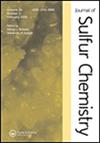Nickel(II) unsymmetrical Schiff base complex immobilized on boehmite nanoparticles: a novel and efficient heterogeneous catalyst for selective oxidation of sulfides and thiols
IF 1.6
3区 化学
Q3 CHEMISTRY, MULTIDISCIPLINARY
引用次数: 0
Abstract
In this work, first, boehmite nanoparticles were prepared by an economical and simple method using accessible materials, and functionalized with 3-chloropropyltrimethoxysilane (3-CPTMS). Then, a nickel(II) unsymmetrical salen Schiff base complex, Ni(salenac-OH), where salenac-OH = [9-(2’,4'-dihydroxyphenyl)−5,8-diaza-4-methylnona-2,4,8-trienato](−2), was synthesized and immobilized on the prepared chloro-functionalized boehmite nanoparticles. The obtained Boehmite@Ni(salenac-OH) nanoparticles were characterized using various techniques. The produced Boehmite@Ni(salenac-OH) nanoparticles were employed as an effective heterogeneous nanocatalyst for the selective oxidation of sulfides to sulfoxides using 30% H2O2 as a green oxidant under solvent-free conditions as well as the oxidative coupling of thiols to disulfides with 30% H2O2 in ethanol at room temperature (25 °C). In these protocols, the desired sulfoxides and disulfides were achieved with good to excellent yields without over-oxidation to unwanted by-products. The use of this heterogeneous nanocatalyst in the mentioned organic reaction achieved good results, including high efficiency, excellent stability, easy recovery, and reusability of the catalyst for five continuous cycles. In addition, XRD and FT-IR techniques indicated that the structure of the catalyst remained intact after the recovery process.
薄水铝石纳米颗粒固定化镍(II)不对称席夫碱配合物:一种新型高效的硫化物和硫醇选择性氧化非均相催化剂
本研究首先采用经济、简单的方法制备了薄水铝石纳米颗粒,并采用3-氯丙基三甲氧基硅烷(3-CPTMS)进行了功能化。然后,合成了镍(II)不对称salenschiff碱配合物Ni(salenech - oh),其中salenech - oh =[9-(2 ',4'-二羟基苯基)- 5,8-二氮杂-4-甲基nona-2,4,8-三烯酸](-2),并将其固定在制备的氯功能化薄铝石纳米颗粒上。所得Boehmite@Ni(salenech - oh)纳米颗粒采用各种技术进行表征。制备的Boehmite@Ni(salenact - oh)纳米颗粒作为一种有效的非均相纳米催化剂,在无溶剂条件下,以30% H2O2作为绿色氧化剂,将硫化物选择性氧化为亚砜,并在室温(25℃)下,以30% H2O2在乙醇中氧化偶联硫醇为二硫化物。在这些方案中,所需的亚砜和二硫化物以良好到优异的产率获得,而不会过度氧化产生不需要的副产物。在上述有机反应中使用该非均相纳米催化剂取得了良好的效果,包括效率高,稳定性好,易于回收,催化剂可重复使用5个连续循环。此外,XRD和FT-IR技术表明,催化剂的结构在回收过程中保持完整。
本文章由计算机程序翻译,如有差异,请以英文原文为准。
求助全文
约1分钟内获得全文
求助全文
来源期刊

Journal of Sulfur Chemistry
CHEMISTRY, MULTIDISCIPLINARY-
CiteScore
4.10
自引率
9.10%
发文量
38
审稿时长
6-12 weeks
期刊介绍:
The Journal of Sulfur Chemistry is an international journal for the dissemination of scientific results in the rapidly expanding realm of sulfur chemistry. The journal publishes high quality reviews, full papers and communications in the following areas: organic and inorganic chemistry, industrial chemistry, materials and polymer chemistry, biological chemistry and interdisciplinary studies directly related to sulfur science.
Papers outlining theoretical, physical, mechanistic or synthetic studies pertaining to sulfur chemistry are welcome. Hence the target audience is made up of academic and industrial chemists with peripheral or focused interests in sulfur chemistry. Manuscripts that truly define the aims of the journal include, but are not limited to, those that offer: a) innovative use of sulfur reagents; b) new synthetic approaches to sulfur-containing biomolecules, materials or organic and organometallic compounds; c) theoretical and physical studies that facilitate the understanding of sulfur structure, bonding or reactivity; d) catalytic, selective, synthetically useful or noteworthy transformations of sulfur containing molecules; e) industrial applications of sulfur chemistry; f) unique sulfur atom or molecule involvement in interfacial phenomena; g) descriptions of solid phase or combinatorial methods involving sulfur containing substrates. Submissions pertaining to related atoms such as selenium and tellurium are also welcome. Articles offering routine heterocycle formation through established reactions of sulfur containing substrates are outside the scope of the journal.
 求助内容:
求助内容: 应助结果提醒方式:
应助结果提醒方式:


